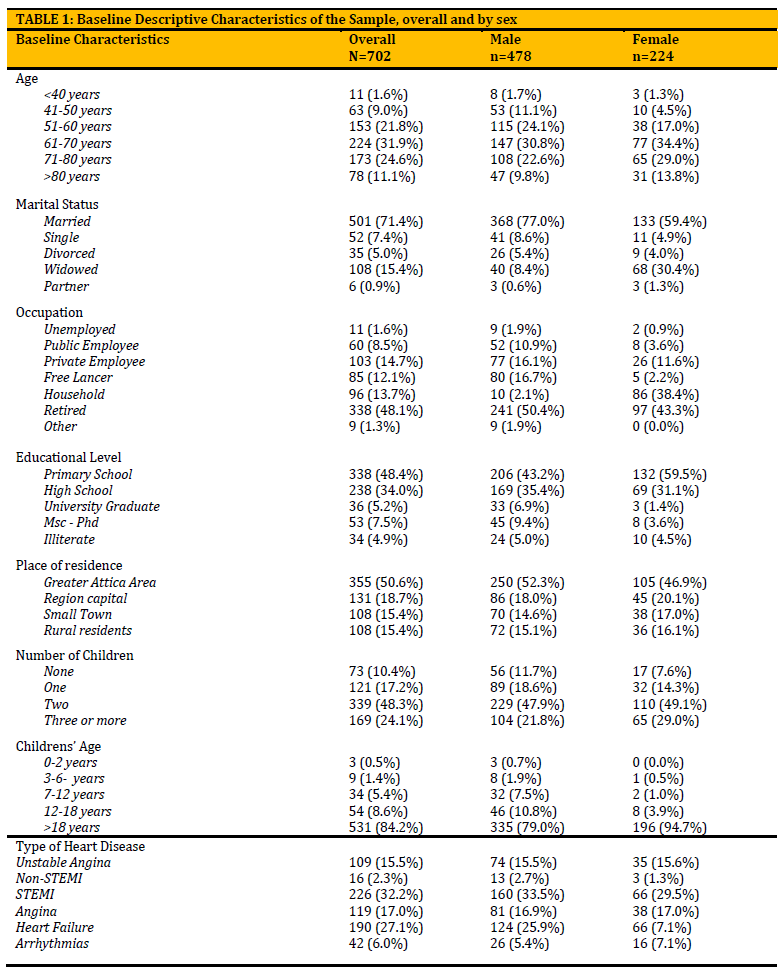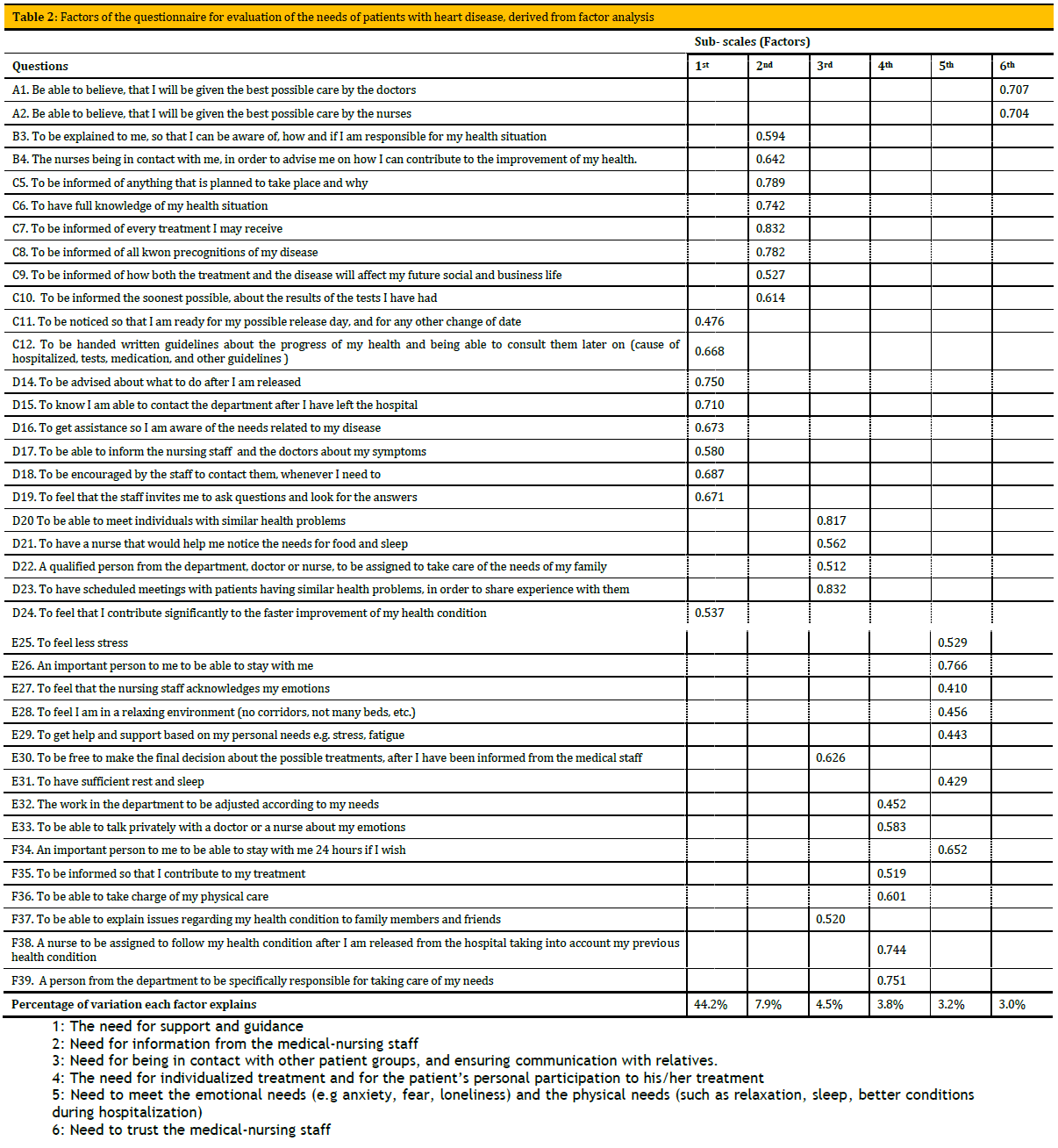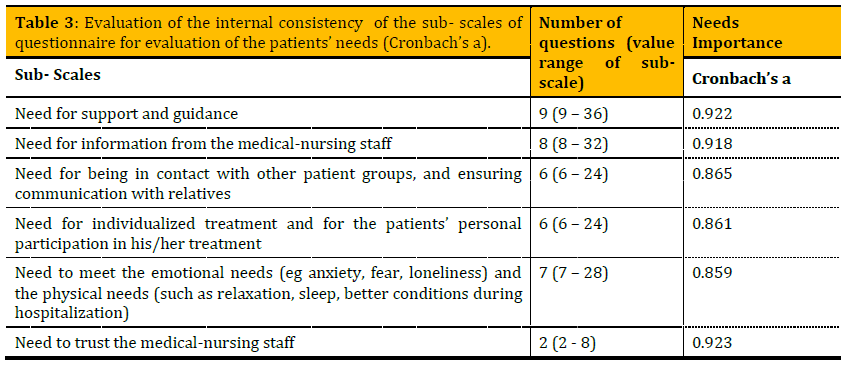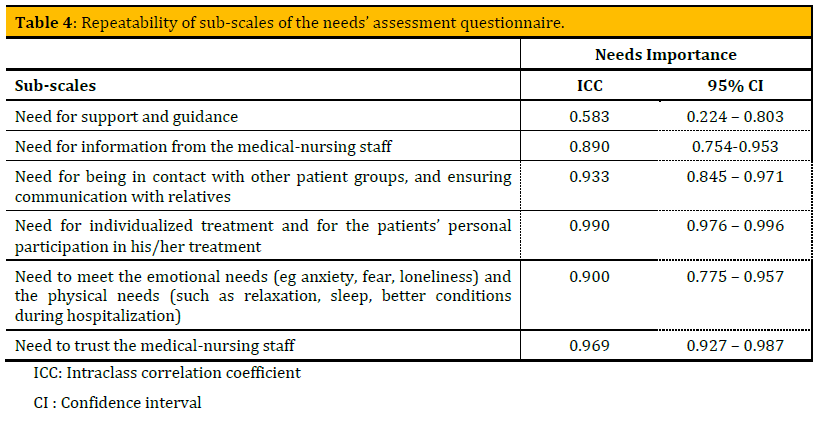Keywords
Hospitalized patients –coronary artery disease-needs of patients
Introduction
Coronary artery disease consists the major cause of morbidity and disability in many developed countries, globally [1,2] . During recent years, due to the increase in life expectancy of coronary disease patients, the interest of health professionals has turned to the assessment and the fulfillment of their needs during hospitalization [3,4] .
Nowadays, it has become evident that the care of hospitalized coronary patients is not only limited to the treatment of the disease and the prevention of complications but also involves assessment of their needs for the provision of high quality of care. According to the literature, there are many definitions proposed for the “need” due to its’ inherent complexity. The "patients’ need" is a dynamic concept that changes over time and the disease progression. Another commonly held view is that the "patients’ need" varies accordingly to the spirituality and cultural traditions of the individuals [5-8] .
Although, considerable advances were made in the last decades in understanding the significance of assessing needs of hospitalized patients with coronary artery disease, however, in daily clinical practice their evaluation is still underestimated, for a variety of reasons such as the lack of time and personnel. Undermining or not assessing the needs of hospitalized patients exerts a negative influence on the outcome of the disease and imposes a tremendous financial burden on the National Health System in each country, whereas their detection, evaluation, and meeting of the patients’ needs may have beneficial effects [9-12] .
Needs of hospitalized patients with coronary artery disease is a qualitative attribute that can be assessed by the use of questionnaire. Though, questionnaires are the most widely used tools especially in large surveys due to the low cost and their ease in apply, however, are subjected to recall bias, thus validation studies should be conducted in order to determine their validity and reliability.
The aim of the present study was to assess validation and reliability of the Needs of hospitalized patients with coronary artery disease .
Method and material
Study Population: The sample size was 702 patients, 478 of whom were men and 224 women with chronic or acute coronary disease (angina, unstable angina, STEMI, non-STEMI, heart failure, arrhythmias). This particular patient sample was a convenience sample.
All patients who met the inclusion criteria of the study and were hospitalized in a cardiology department or intensive care unit (ICU) the fourth day after the rectory of four public hospitals in Attica and two public hospitals of the province during the period June 2009 - June 2010 were included in the study. The inclusion criteria for the study were medical attendance due to coronary heart disease for at least 3 days, and a good knowledge / use of the Greek language. Patients who met the inclusion criteria participated in the study after they had been orally informed for the purposes of the study and oral consent for their participation had been taken.
The method for the data collection was interview, using a specially modified questionnaire, which it fully met the requirements of the current study and consisted of the questions of “assessment of the needs of patients hospitalized with coronary artery disease” and descriptive characteristics. Specifically :
Assessment of the needs of patients hospitalized with coronary artery disease: To assess the needs of hospitalized coronary patients of this study, a questionnaire of 39 questions regarding potential needs of patients with coronary artery disease during hospitalization was developed by the researchers. These questions were selected according to the Kristjandottir [13,14] questionnaire, that evaluates the needs of hospitalized children’s parents and has been translated and used in Greece by Kyritsi et al [15] . Moreover, information from extensive literature review on the needs of hospitalized coronary disease patients, and informal interviews conducted by the researchers with patients and health professionals, were used. In addition, the questions were chosen in order to cover a wide range of the hospitalized patients’ needs. More specifically, the questions were initially grouped according to their content in the following 6 categories of necessities: a) need for support and guidance, b) need for information from the medical-nursing staff, c) need for being in contact with other patient groups, and ensuring communication with relatives, d) need for individualized treatment and for the patient’s personal participation to his/her treatment e) need to meet the emotional needs (e.g anxiety, fear, loneliness) and the physical needs (such as relaxation, sleep, better conditions during hospitalization), f) need to trust the medical-nursing staff. The Likert type four-scale was used to answer all questions. The four different scales were represented the following answers: No, Little, Μuch and Too Much. The process of filling out the questionnaires took between 15 and 30 minutes.
Reliability and validity assessment of the questionnaire:
Validity: Initially, the questionnaire, immediately after the design, was submitted to 15 patients to determine whether the questions were clear, understandable, and in a logical order (face validity). Moreover, the same patients and 5 health professionals who had long experience in working with heart failure patients were asked to criticize the content of the questionnaire (content validity).
More specifically, they were asked to express their views on whether they consider these 39 questions to be representative of the needs of patients with coronary artery disease or if some additional statements need to be added. The construct validity of the questionnaire was tested using the appropriate statistical technique in order to determine the structure of the questionnaire, namely the number of sub-scales measured by this questionnaire, and the questions that constitute each sub-scale. For the construct validity evaluation, the 39 questions were used relatively to the importance of the 39 statements that assess the needs of patients. The criterion validity of the questionnaire was not checked, as a gold standard tool for assessment of the hospitalized patients’ needs has not been proposed yet.
Reliability: Finally, the internal consistency and the repeatability of each sub-scale derived from the construct validity of the questionnaire was tested using the appropriate statistical test. In particular, 50 patients were use in order to assess the repeatability. These patients completed the questionnaire two times. Between the two measurements there was a period of three to four days.
Base line characteristics : The type of coronary disease and a number of socio-demographic characteristics of patients who participated were collected. More specifically, the following were recorded: sex and age of the participants, marital status, educational level, place of residence, number of children, and age of children.
The study was approved by the Medical Research Ethics Committee of each hospital and was conducted in accordance to the World Medical Association’s Declaration of Helsinki (1989).
Statistical analysis
Evaluation of the validity and reliability of questionnaires
Evaluation of the face and content validity was performed by asking 15 patients and 5 health professionals, respectively, to evaluate the clarity and plenitude/ representativeness of the questions regarding the assessment of hospitalized coronary disease patient’s needs. The factor analysis was used to evaluate the construct validity of the needs’ questionnaire. The suitability of the data for carrying out such analysis was tested by using the Bartlett sphericity test and the Kaiser-Meyer-Olkin (KMO) statistic test that evaluates the degree of correlation among the questions included in the questionnaire.
Statistically significant results of the sphericity test indicates that the variance-covariance matrix of the initial questions of the questionnaire is not diagonal (ie, variables are correlated with each other). Also, values of KMO> 0.8 indicate a fairly high correlation and therefore, factor analysis is meaningful. The method of "Analysis of Principal Components” was used for assessment of the main factors. The criterion of Kaiser (eigenvalue > 1) was used to determine the number of factors derived from the factor analysis. An orthogonal rotation (i.e. Varimax) was used to improve the explanatory ability of the factors. Each factor that emerged was interpreted based on the questions that had load value > 0.4.
Evaluation of the internal consistency of the sub-scales for the patients' needs questionnaire was carried out by calculating the Cronbach Alpha coefficient. This coefficient ranges from 0 - 1. Large Cronbach Alpha values indicate a high consistency of the questions of which the sub-scale is consisted. The “Cronbach Alpha if item deleted” index was used to identify the questions that reduced the internal consistency of the questionnaire and therefore had to be excluded.
The repeatability of questionnaire was evaluated by using the Intra-class correlation coefficient (ICC), which takes values between -1 and +1. Values proximate to +1 show high repeatability of the questionnaire. The results are shown as ICC (95% confidence interval).
Descriptive statistics: Evaluation for normality of distribution of the continuous variables (e.g sub-scales of the needs of patients) was tested by the Kolmogorov-Smirnov test. The categorical data are presented as absolute and relative (%) frequencies, while the continuous data are presented as mean values ± standard deviations, except days of hospitalization which are presented as median and interquartile range.
All statistical analysis was carried out using SPSS program, version 17 (SPSS Inc, Chicago, Il, USA).
Results
Descriptive results
Table 1 presents the baseline characteristics of the participants. It was observed that the majority of the participants were married (71.4%) and between 50-80 years old (78.3%). About 50% of the participants were retired (48.1%), primary school graduates (48.4%) and had 2 children (48.3%).

The majority of those with children (84.2%) reported that their children had already entered adulthood. Regarding area of residence, almost half of the participants were leaving in the greater area of Attica, while the rest of the participants were coming from either the countryside, a small town or the capital of a region with the same frequency. Regarding distribution by sex of the above socio – demographic characteristics, the percentage of female primary school graduates (59.5%) was significantly higher than the men’s percentage (43.2%).
Relatively to the patients’ occupation, although the majority of both sexes claimed to be retired, there was a distinct number of people who reported housekeeping as occupation. In particular, the percentage of female patients was 38.4%, in opposition to males’ percentage which was 2.1%.
Regarding the coronary disease type, the most common type was ST Elevation Myocardial Infraction-STEMI (32.2%) and heart failure (27.1%), while the least common was the non-STEMI Myocardial Infraction.
Statistic results
Regarding face and content validity both patients and experts reported that the statements were clear, easy to understand, in a logical order, and totally representative of the needs of the hospitalized patients.
Construct validity of the questionnaire for evaluation of the patient’s needs. : As it is already mentioned, factor analysis was performed for the evaluation of the construct validity of the questionnaire for the patients’ needs. Initially, the relevance of the data used for the factor analysis was confirmed. The statistical ctiteria Kaiser-Meyer-Olkin (KMO=0,948) and the Bartlett Test of sphericity (value 20,230.187, p<0.001), indicated that the raw data were suitable for the implementation of factor analysis
From the 39 original questions used in the factor analysis, 6 factors came off, using the Kaiser criterion and Varimax orthogonal rotation. The only statement that was removed from the original version of the questionnaire was "to be able to see a social worker to get information on treatment charges."
As shown in Table 2, the first factor consists of 9 questions and indicates "the need for support and guidance of the patient." This factor explains the bulk of the variability of the original data (44.2%). The second factor consists of 8 questions and expresses "the need for information to the patient from the medical-nursing staff. The percentage of variability in the data interpretation by this factor is estimated to 7.9%. The third factor consists of 6 questions and expresses "the need for being in contact with other patient groups, and ensuring communication with relatives". This particular factor explains 4.5% of the variability of the data. The fourth factor consists of 6 questions and expresses "the need for individualized treatment and the patient’s personal participation to his/her treatment." This particular factor explains 3.8% of the variability of the data. The fifth factor consists of 7 questions and express "the need to meet the emotional needs (eg anxiety, fear, loneliness) and physical needs (such as relaxation, sleep, better treatment) of the patient. This particular factor explains 3.2% of the variability of the data. Finally, the sixth factor consists of 2 questions and expresses "the need for patients to trust the medical-nursing staff. This particular factor explains 3.0% of the variability of the data.

The overall rate of variation of initial data the 6 factors interpret in common, amounts to 66.6%.
Evaluation of the internal consistency of the questionnaire for the patients' needs assessment: Table 3 shows the detailed results of the evaluation of the internal consistency for each sub-scale (factor) of the questionnaire of patients' needs assessment, as those derived from the factor analysis. Table 3 shows that the internal consistency of the questions making up each sub-scale is extremely high (Cronbach's a> 0.8). Also Table 3 shows the range of each sub-scale. Higher values indicate higher significance of the specific needs of the patients during hospitalization.

The evaluation of repeatability showed that all sub-scales of questionnaire were highly repeatable, with the exception of the need for guidance and support which the repeatability was fund to me moderate. These results are shown in Table 4.

Discussion
In the current work, the reliability and validity of a Greek questionnaire for assessment of coronary artery disease patients’ needs was examined. This questionnaire is an adaptation of the questionnaire developed by Icelander Gudrún Kristjánsdóttir to assess how parents perceive the needs of their children emerging during their hospitalization, as well as the importance of those needs and how they are met [13,14] . To the best of our knowledge, this questionnaire has been used in other studies and countries : in Iceland [16] , Portugal [17] , Sweden [18,19] and in England [20] . In Greece, this questionnaire was used by Kyritsi et al., [15] who explored the needs of 150 parents during their child’s hospitalization.
The results of the present study showed that the questionnaire is a valid and reliable measurement instrument of the needs of hospitalized patients with coronary artery disease. The needs of hospitalized patients with coronary artery disease shown in the present study are: a) The need for support and guidance, b) need for information from the medical-nursing staff, c) need for being in contact with other patient groups, and ensuring communication with relatives, d) need for individualized treatment and for the patient’s personal participation to his/her treatment e) need to meet the emotional needs (eg anxiety, fear, loneliness) and the physical needs (such as relaxation, sleep, better conditions during hospitalization), f) need to trust the medical-nursing staff.
To the best of our knowledge, a similar study has been conducted in 2003 by Asadi-Lari et al [10] . In this study, a questionnaire that assessed three patients’ needs (i.e. help need, overall social needs and overall physical needs) was used.
All the needs are essential for the development of dynamic and interacting therapeutic relation between health professionals and patients. More specifically, assessment of the needs of patients with coronary artery disease, contributes to the best implementation of any medical / nursing practice, reduces their anxiety, and ensures their cooperation. Moreover, it enables patients to understand the medical instructions in detail, to accept their medical state and to comply with the treatment. Recent studies have shown that meeting the needs of patients with coronary artery disease is associated with a statistically significant reduction in mortality, morbidity, re-hospitalizations and healthcare costs [9-12,21-24] .
It is worth mentioning that assessment of needs is not always possible in patients with coronary artery disease. For example, the patients in sudden heart attack have not any choice but to follow the instructions and the care of health professionals. On the contrary, assessing the needs of patients who suffered myocardial infarction or in those suffering from congestive heart failure is matter of vital importance during the process of deciding the appropriate therapeutic approach or during the recovery process [9-12,21-23] .
The assessment of needs for hospitalized patients with coronary artery disease is a process that should be an integral part of the treatment, starting very early, from the diagnosis stage until the discharge from hospital. According to Asadi-Lari et al., [10] medical professionals tend to focus on a medical model of health care, ignoring the more comprehensive approach which addresses 'the state of physical, mental and social well being'.
However, in the Greek health system, systematic measurement of patients' needs as well as comparative studies regarding this subject are lacking.
Conclusion
The questionnaire is a valid and reliable measurement instrument of the needs of hospitalized patients with coronary artery disease. Understanding the importance of assessing needs of hospitalized patients by the completion of the present questionnaire should prompt health professionals to provide care of high quality, identifying areas for potential improvements that are not directly related to physical conditions.
Acknowledgment
It is a pleasure to thank those who made this research possible and supported the project : Patsilinakos Sotirios (Head, Department of Cardiology, N. Ionia General Hospital “Ag. Olga”) and Spyridon Zobolos (Head, Department of Cardiology, Kalamata Hospital).
3431
References
- Stephanadis Ch. Heart disease. Ed. Paschalidis, Athens, 2005. (In Greek)
- Babatsikou F. Epidemiological data of cardiovascular diseases in the elderly. To VimatouAsklipiou, 2010;9(3):230-242. (In Greek)
- Robinson J, Elkan R. Health needs assessment, theory and practice. New York, Churchill Livingstone, 1996.
- Polikandrioti M, Ntokou M. Needs of hospitalized patients. Health Science Journal, 2011;5(1):15-22.
- Stevens A, Gillam S. Needs assessment: from theory to practice. BMJ. 1998;316(7142):1448-52.
- James M. Towards an integrated needs and outcome framework. Health Policy. 1999;46(3):165-177. doi: 10.1016/S0168-8510(98)00064-5.
- Robinson J, Elkan R. Health needs assessment, theory and practice. New York, Churchill Livingstone, 1996.
- Davidson PM, Macdonald P, Moser DK, Ang E, Paull G, Choucair S, et al. Cultural diversity in heart failure management: findings from the DISCOVER study (Part 2). Contemp Nurse. 2007;25(1-2):50-61.
- Asadi-Lari M, Packham C, Gray D. Need for redefining needs. Health Qual Life Outcomes. 2003;1:34.
- Asadi-Lari M, Packham C, Gray D. Unmet health needs in patients with coronary heart disease: implications and potential for improvement in caring services. Health Quality Life Outcomes. 2003;1:26.
- Asadi-Lari M, Packham C, Cray D. Psychometric properties of new health needs analysis tool designed for cardiac patients. Public Health. 2005;119(7):590-98.
- Hawe P. Needs assessment must become more change-focused. Aust N Z J Public Health. 1996;20(5):473-8.
- Kristjandottir G. Perceived importance of Needs expressed by parents of hospitalized two to six years old. Scand J Caring Sci. 1995;9(2):95-103.
- Kristjánsdóttir G. A study of the needs of parents of hospitalized 2- to 6-year-old children. Issues ComprPediatrNurs. 1991;14(1):49-64.
- Kyritsi H, Matziou V, Perdicaris P, Evagelou H. Parents' needs during their child's hospitalization. ICUS Nurs Web J 2005, 23:1-9.
- Bragadottir H. A descriptive study of the extent to which self-perceived needs of parents are met in pediatric units in Iceland. Scand J Caring Sci. 1999;13:201-7.
- Ferreira PL, Melo E, Reis G, Mello DF. Validation and reliability analysis of the Portuguese language version of Needs of Parents Questionnaire. J Pediatr (Rio J). 2010;86(3):221-7.
- Shields L, Kristensson-Hallström I, O’callaghan M. An examination of the needs of parents of hospitalized children: Comparing parents’ and staff’s perceptions. Scand J Caring Sci. 2003;17:176-84.
- Shields L, Kristensson-Hallstrom I. We have needs too: parental needs during a child's hospitalization. Online Braz J Nurs. 2004;3:e.https://www.uff.br/nepae/siteantigo/objn303shieldsetal.htm. Access: 30/04/2006.
- Shields L, Hunter J, Hall J. Parents' and staffs perceptions of parental needs during a child's admission to hospital: an English perspective. J Child Health Care. 2004;8:9-33.
- Theobald K, McMurray C. Coronary artery by pass graft surgery : discharge planning for successful recovery. J Adv Nurse. 2004;47:483-91.
- Seddon ME, Marshall MN, Campbell SM, Roland MO. Systematic review of studies of quality of clinical care in general practice in the UK, Australia and New Zealand. Qual Health Care. 2001;10(3):152-8.
- Bethell H, Lewin R, Dalal H. Cardiac rehabilitation in the United Kingdom. Heart. 2009;95(4):271-5.









